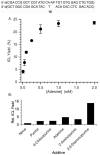Abasic and oxidized abasic site reactivity in DNA: enzyme inhibition, cross-linking, and nucleosome catalyzed reactions
- PMID: 24369694
- PMCID: PMC3944396
- DOI: 10.1021/ar400229d
Abasic and oxidized abasic site reactivity in DNA: enzyme inhibition, cross-linking, and nucleosome catalyzed reactions
Abstract
Abasic lesions are a family of DNA modifications that lack Watson-Crick bases. The parent member of this family, the apurinic/apyrimidinic lesion (AP), occurs as an intermediate during DNA repair, following nucleobase alkylation, and from random hydrolysis of native nucleotides. In a given day, each cell produces between 10000 and 50000 AP lesions. A variety of oxidants including γ-radiolysis produce oxidized abasic sites, such as C4-AP, from the deoxyribose backbone. A number of potent, cytotoxic antitumor agents, such as bleomycin and the enediynes (e.g., calicheamicin, esperamicin, and neocarzinostatin) also lead to oxidized abasic sites in DNA. The absence of Watson-Crick bases prevents DNA polymerases from properly determining which nucleotide to incorporate opposite abasic lesions. Consequently, several studies have revealed that (oxidized) abasic sites are highly mutagenic. Abasic lesions are also chemically unstable, are prone to strand scission, and possess electrophilic carbonyl groups. However, researchers have only uncovered the consequences of the inherent reactivity of these electrophiles within the past decade. The development of solid phase synthesis methods for oligonucleotides that both place abasic sites in defined positions and circumvent their inherent alkaline lability has facilitated this research. Chemically synthesized oligonucleotides containing abasic lesions provide substrates that have allowed researchers to discover a range of interesting chemical properties of potential biological importance. For instance, abasic lesions form DNA-DNA interstrand cross-links, a particularly important family of DNA damage because they block replication and transcription absolutely. In addition, bacterial repair enzymes can convert an interstrand cross-link derived from C4-AP into a double-strand break, the most deleterious form of DNA damage. Oxidized abasic lesions can also inhibit DNA repair enzymes that remove damaged nucleotides. DNA polymerase β, an enzyme that is irreversibly inactivated, is vitally important in base excision repair and is overproduced in some tumor cells. Nucleosome core particles, the monomeric components that make up chromatin, accentuate the chemical instability of abasic lesions. In experiments using synthetic nucleosome core particles containing abasic sites, the histone proteins catalyze strand cleavage at the sites that incorporate these lesions. Furthermore, in the presence of the C4-AP lesion, strand scission is accompanied by modification of the histone protein. The reactivity of (oxidized) abasic lesions illustrates how seemingly simple nucleic acid modifications can have significant biochemical effects and may provide a chemical basis for the cytotoxicity of the chemotherapeutic agents that produce them.
Figures
















References
-
- Lindahl T. Instability and Decay of the Primary Structure of DNA. Nature. 1993;362:709–715. - PubMed
-
- Pitié M, Pratviel G. Activation of DNA Carbon Hydrogen Bonds by Metal Complexes. Chem. Rev. 2010;110:1018–1059. - PubMed
-
- Loeb LA, Preston B,D. Mutagenesis by Apurinic/Apyrimidinic Sites. Ann. Rev. Genet. 1986;20:201–230. - PubMed
-
- Kroeger KM, Jiang YL, Kow YW, Goodman MF, Greenberg MM. Mutagenic Effects of 2-Deoxyribonolactone in Escherichia Coli. An Abasic Lesion That Disobeys the A Rule. Biochemistry. 2004;43:6723–6733. - PubMed
Publication types
MeSH terms
Substances
Grants and funding
LinkOut - more resources
Full Text Sources
Other Literature Sources
Miscellaneous

